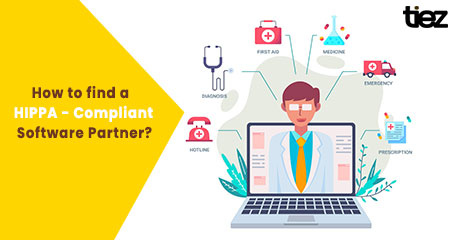In the healthcare industry, patient data privacy is paramount. The Health Insurance Portability and Accountability Act (HIPAA) sets strict regulations for safeguarding patients’ electronic protected health information (ePHI). When developing healthcare software, ensuring compliance with HIPAA is not just an option, it’s a legal requirement. However, navigating the intricacies of HIPAA compliance and finding a suitable development partner can be challenging. This blog will guide you through understanding HIPAA, key features of compliant software, and critical criteria for selecting a HIPAA-compliant healthcare software development and application modernization company.
What is HIPAA Compliance and Why is it Important?
HIPAA is a set of federal regulations that govern the use, disclosure, and security of protected health information. It applies to all entities, including healthcare providers, health plans, and healthcare clearinghouses, that electronically transmit, receive, or maintain patient data.
Non-compliance with HIPAA can lead to significant consequences, including hefty fines, reputational damage, and even criminal charges. More importantly, non-compliance puts patient data at risk, potentially impacting their well-being and trust in healthcare institutions.
Key Features of HIPAA-Compliant Software
HIPAA compliance is an ongoing process, not a one-time achievement. Here are some crucial features that a compliant healthcare software application should possess:
1. Data Encryption:
Encryption at Rest and in Transit: Sensitive patient data should be encrypted both when stored within the system (“at rest”) and while being transmitted electronically (“in transit”). Encryption renders data unreadable by unauthorized individuals, even if intercepted.
Types of Encryption: Common encryption methods include AES (Advanced Encryption Standard) and RSA (Rivest–Shamir–Adleman). The specific chosen method depends on the sensitivity of the data and security requirements.
2. Access Controls:
Role-Based Access Control (RBAC): RBAC restricts access to ePHI based on a user’s assigned role and permissions. Only authorized personnel with a legitimate need for access should have the ability to view or modify patient data.
Authentication and Authorization: Multi-factor authentication strengthens access control by requiring users to verify their identity with additional factors beyond a username and password. Authorization determines what actions a user can perform within the software.
3. Audit Controls:
Tracking ePHI Access: The software should maintain detailed logs of all access attempts to ePHI, including the user, time, and type of access. This allows for monitoring suspicious activity and identifying potential breaches.
Regular Audits and Reviews: Healthcare organizations should conduct regular audits to assess and verify the effectiveness of HIPAA compliance controls.
4. Data Integrity:
Protecting ePHI from Unauthorized Changes: Mechanisms should be in place to ensure that patient data cannot be altered or destroyed without authorization. Digital signatures and version control can help maintain data integrity.
5. Transmission Security:
Secure Communication Protocols: During electronic transmission of ePHI, secure protocols such as HTTPS (Hypertext Transfer Protocol Secure) should be used. HTTPS encrypts data in transit, protecting it from interception.
6. Disaster Recovery and Backup:
Data Backup and Recovery Plan: A robust plan for data backup and recovery is crucial in the event of a disaster or system failure. Regular backups and secure storage of data ensure its availability and facilitate restoration in case of a data breach.
Criteria for Choosing a HIPAA-Compliant Developer
Selecting the right healthcare software development partner is vital for ensuring patient data security and project success. Here are crucial factors to consider:
1. Experience and Expertise:
Domain Knowledge: Choose a company with experience and a proven track record in developing healthcare software. Understanding the nuances of healthcare data and workflows is essential for building compliant solutions.
HIPAA Regulations Expertise: The development team should possess a thorough understanding of HIPAA regulations and best practices for implementing HIPAA-compliant features within the software.
2. Certifications and Compliance:
Industry-Specific Certifications: Look for certifications like HITRUST (Health Information Trust Alliance) or SOC 2 (Service Organization Controls) that demonstrate the company’s commitment to data security and compliance.
Verification of HIPAA Compliance: Don’t hesitate to request documentation and evidence of the company’s HIPAA compliance policies and procedures.
3. Client Reviews and Testimonials:
Third-Party Review Platforms: Check for reviews on platforms like Clutch, GoodFirms, and Google. Testimonials from past clients can offer valuable insights into the company’s experience, communication style, and commitment to quality.
4. Technical Skills and Capabilities (Continued):
HIPAA-Compliant Development Practices: Ensure the company employs secure development methodologies and best practices aligned with HIPAA compliance requirements.
5. Communication and Project Management:
Clear Communication Channels: Establish clear and consistent communication channels with the development team. Regular communication is vital for keeping everyone aligned with project goals and ensuring timely completion.
Transparent and Agile Project Management: A transparent and well-defined project management methodology ensures project progress is tracked effectively. Agile methodologies can be advantageous as they allow for iterative development and adaptation to changing requirements.
6. Post-Development Support and Maintenance:
Ongoing Support and Updates: HIPAA regulations are constantly evolving. Choose a development partner that offers ongoing support and updates to ensure your software remains compliant with the latest regulations.
Reliable Maintenance Services: Regular bug fixes, security patches, and performance enhancements are essential for maintaining the software’s functionality and security.
Red Flags to Watch Out For
While searching for a development partner, be wary of certain red flags:
Lack of Transparency: If a company is hesitant to share details about their HIPAA compliance measures, it’s a cause for concern. Transparency is key when dealing with sensitive patient data.
No Prior Healthcare Experience: Development experience in healthcare is crucial for understanding the complexities of the industry and the specific needs of healthcare software.
Poor Communication and Project Management: Unclear communication or disorganized project management processes can lead to delays, misunderstandings, and potentially compromised data security.
Inadequate Post-Development Support: Investing in a development partner that prioritizes ongoing support and maintenance is vital for long-term success.
Steps to Engage with a Healthcare Software Development Company
Once you’ve identified potential partners, take these steps to establish a successful collaboration:
1. Initial Consultation:
Discuss Project Requirements: Clearly communicate your project objectives, functionalities, and data security needs.
Assess HIPAA Understanding: Ask questions to gauge the company’s understanding of HIPAA regulations and their approach to implementing HIPAA-compliant features.
2. Request for Proposal (RFP) and Quotation:
Detailed RFP: Prepare a detailed RFP outlining project scope, functionalities, timelines, and desired HIPAA compliance features.
Evaluate Proposals: Carefully evaluate proposals based on cost, technical expertise, proposed approach to HIPAA compliance, and experience in healthcare software development.
3. Evaluation and Shortlisting:
Selection Criteria: Define clear criteria for evaluating proposals, such as experience, qualifications, communication style, and cost-effectiveness.
Shortlist Candidates: Shortlist a few top contenders based on your defined criteria for further evaluation.
4. Final Decision and Contract Signing:
In-Depth Discussions: Schedule in-person meetings or video calls with shortlisted companies for in-depth discussions and team evaluation.
Clear Contract Terms: Ensure the final contract clearly outlines project scope, timelines, deliverables, payment terms, and HIPAA compliance responsibilities.
By following these steps and conducting thorough due diligence, you can increase your chances of finding a reputable and HIPAA-compliant healthcare software development partner. Remember, a successful partnership hinges on open communication, a shared commitment to data security, and a dedication to developing reliable and secure healthcare software applications.
Conclusion
HIPAA compliance is an essential element of responsible healthcare software development. By understanding the key features of compliant software and selecting the right software development partner, you can ensure patient data remains protected and compliant with regulations. This not only safeguards patient privacy but also fosters trust and promotes a positive impact on the healthcare industry as a whole.

